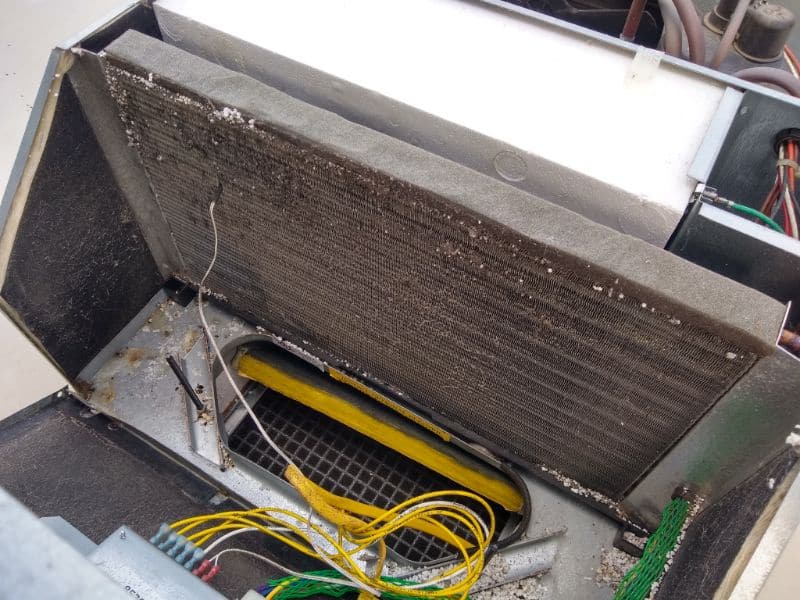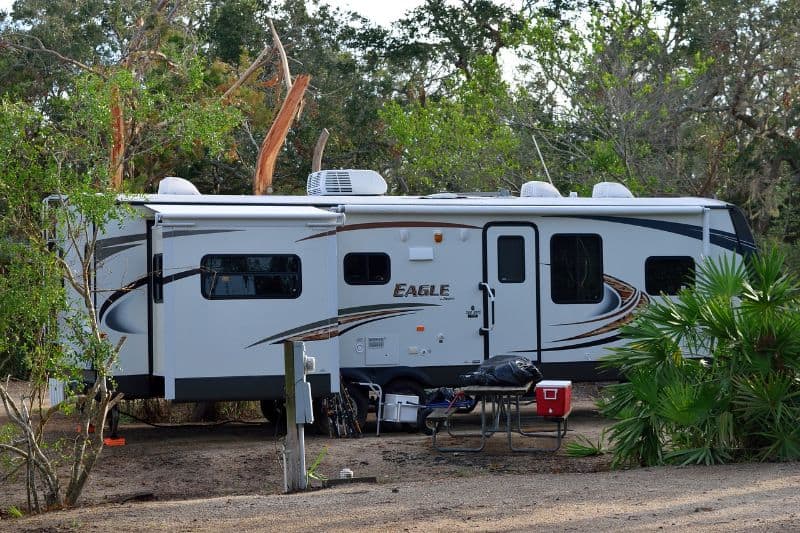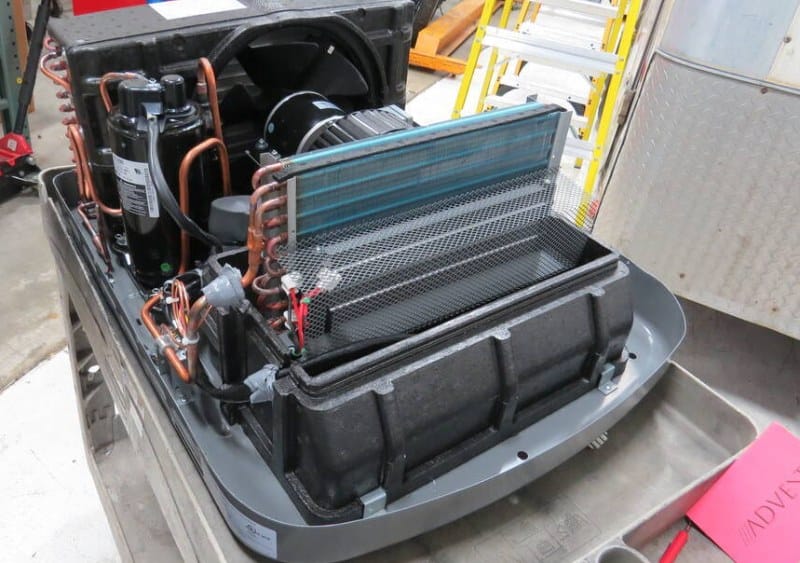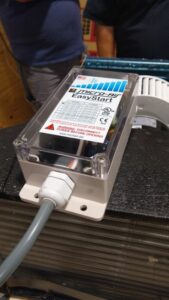Welcome to my conspectus on the ubiquitous RV air conditioner. This post is for any and all RV owners!
I’m going to serve up some FAQs about RV air conditioners, especially rooftop units. Even if you’re a seasoned pro, I think you’ll find some delicious information nuggets you didn’t know you didn’t know. Bon appetite!
What I Want You to Know RIGHT NOW About RV Air Conditioners
If you’re the sort of Reader who screams “Squirrel!” and quits a blog post midstream, then here are the three things I want you to know right now:
- RV air conditioners will cool the outgoing air about 20 degrees less than the incoming air. You can help your RV by limiting heat gain (park in the shade, close window screens, etc.)
- No, you can’t run your RV air conditioner off your battery.
- Do yourself a favor and purchase a Soft Start if your A/C doesn’t have one!
How Does RV Air Conditioning Work?
From an engineering perspective, an RV air conditioner isn’t anything special. It operates on the same vapor-compression cycle as your house air conditioner, car air conditioner, window air conditioner, or refrigerator.

If you ever want to take apart an RV air conditioner, you’ll see what I mean. You’ll see condenser fins, evaporator fins, the compressor, a blower fan, a PCB, some copper tubing, a sheet metal enclosure, and some insulation. That’s pretty much it.
What you should know is that the difference in quality usually comes down to:
- Fan/plenum design;
- Choice of compressor.
The Furrion Chill air conditioner, for instance, uses dual fans to increase efficiency up to 40 percent! And it’s quieter, too. But under the hood, a Dometic still looks a lot like a Coleman, and vice versa.
Performance Limitations
You should realize that an air conditioner doesn’t cool down hot outside air. It just circulates the inside air, making it colder and colder. All the heat is supposed to be exhausted to the outdoors. That’s why the hotter the temperature, the harder the A/C has to work!
RV air conditioners are designed to cool about 20 degrees. One common misconception – I used to believe it too! – is that air rooftop can only cool about 20 degrees less than the ambient air temperature. In other words, if you’re parked in the sun during a 110-degree Arizona day and it’s hovering at 90 degrees inside, don’t be surprised. But this is wrong. Air conditioners have a delta T – a change in temperature – of about 20 degrees between the incoming air and the cooled air, both of which are from the interior of your camper. High humidity can lower the delta T to around 10-14 degrees.
You can improve the performance of your air conditioner by following these rules:
- Maintain your air conditioner! Keep it ship-shape.
- Park in the shade and close your blinds or curtains.
- Open your windows and turn on your fan for 3-5 minutes to exhaust any superheated air before turning on your air conditioner.
Types of RV Air Conditioners
- Rooftop: I’d estimate 99% of North American RVs have rooftop-mounted air conditioners. Most of the information in this article applies to rooftop units.
- Underbench: Popular in Europe, underbench air conditioners are often heat pumps as well. They’re commonly used in Class B vans and micro travel trailers. They tend to be much quieter, more efficient, and more expensive than rooftop units.
- Window/Thru-the-Wall: Occasionally, you might find an RV or an RV conversion (aka skoolie, live-in cargo trailer) with a window-mounted or through-the-wall air conditioner. These A/Cs are designed for residential dwellings, not RVs, but space constraints sometimes force RV designers to make do with what they got!
- Mini split: In exceptionally rare cases, you might see an RV with a mini-split (also called ductless) system. I’m unabashedly in love with mini-splits (Mr. Cool and Mitsubishi are big brands), but they’ve yet to make much headway into the RV market. You’ll only find them on premium 5th wheels and Class A motorhomes.
Ducted Vs Ductless
A lot of RV air conditioners can be installed as ducted or ductless units; some can only be one or the other.
Simply put, a ductless unit circulates air directly through the interior shroud. There’s no ducting, vents or registers anywhere else in the RV. Ductless systems are common in smaller travel trailers and Class B vans.
Meanwhile, a ducted system includes – you guessed it! – HVAC ducts throughout the RV. These ducts are usually located in the attic (roof) or within the floor/basement. They are typically rectangular in shape and made of taped foam board.
Ducted systems are more common with larger RVs that have multiple air conditioners. With a ducted system, you can deliver cold air to individual rooms, and you can open or close vents to your level of comfort.
One isn’t inherently better than the other. Ductless systems are efficient and simple, but they struggle to cool larger partitioned areas. And they’re loud. Ducted systems can lose some efficiency, but they work better for larger RVs with multiple rooms and/or multiple air conditioners.
Brands of RV Air Conditioners
Fun fact: There are only two major manufacturers of rooftop RV air conditioners: Airxcel, who owns Coleman-Mach; and Dometic, who also owns Atwood. Two other upstart brands include Advent, owned by ASA Electronics, and Furrion, owned by Lippert.
To recap:
- Dometic | Atwood
- Airxcel | Coleman-Mach
- Advent
- Furrion
P.S. You also might hear about a Houghton air conditioner. These are aftermarket units that are quite popular for their quiet operation and low power draw. You can’t buy a Houghton direct, but you can buy them at RecPro, their US distributor.
How Do I Maintain an RV Air Conditioner?
Here are five quick tips for taking care of your air conditioner:
- Remove debris inside or around the air conditioner pan, beneath the shroud.
- Clean the air conditioner filter every two weeks of use!
- Keep the condenser and evaporator coils/fins nice and clean!
- Don’t operate the air conditioner in “brown-out” conditions (check using an EMS surge protector).
- Don’t let the compressor over-cycle.
Here are some more of my tips for keeping your RV cool in a hot summer!

How Much Does an RV Air Conditioner Cost?
- On the cheap end, about $600.
- Most cost about $800 – $1,100.
- Premium air conditioners can cost up to $2,000!
What’s the Correct Size of an RV Air Conditioner?
RV air conditioners are rated by BTUs. Here are three common sizes:
- 11,000 BTU (Small): You typically only find 11k BTU air conditioners in specialty applications, such as where a low height is required, or where energy consumption should be minimal. Surprisingly, these less-powerful air conditioners can be some of the most expensive! You can find RV air conditioners with BTU ratings all the way down to 8,000-9,000 BTUs.
- 13,500 BTU (Medium): This is probably the most common size of rooftop air conditioner. They generally draw 10-14 amps while running on High.
- 15,000 BTU (Large): These are the Big Daddies, the ones you find on larger units, especially units with greater vertical height (like toy haulers). Units with multiple 15k BTU A/Cs normally have 50A service.
You want 500-750 BTUs of cooling capacity per foot of your RV. If you camp in Florida, Texas, or Arizona, definitely aim for that 750 mark!
That means RVs longer than 30 feet should usually have two air conditioners. In extremely large (40+ feet) 5th wheels and Class A’s, you might even have three air conditioners!
Can I Run an RV Air Conditioner All Day?
Sure. No law says you can’t! Most aren’t designed for tens of thousands of hours of run-time, however, so don’t be surprised if it conks out in 3-5 years.
Also, be aware that RV air conditioners have very poor efficiency compared to residential air conditioners. RV A/Cs are exempt from EIA SEER requirements, and based on some of my calculations, they’re pretty bad. If you’re paying per kWh at your campsite, be prepared to cough up!
Are RV Air Conditioners Universal?
It’s a common question: Are all RV air conditioners the same?
I’m assuming you’re asking if all RV air conditioners are interchangeable? The answer depends on whether you’re an OEM or buying aftermarket. Unfortunately, switching brands can be a big PITA.
From the OEM perspective, if you want to change air conditioners, it’s not that big a deal. The standard RV air conditioner roof opening size is 14×14 inches (or an ⅛” to a ¼” larger). Pretty much every North American rooftop RV can fit in that space. So no problem there.
But you might have an issue with wiring if you, say, upsize from a 13.5k BTU to a 15k BTU air conditioner. You need to double-check with your manufacturer and ensure the wiring is rated for the higher amperage draw! Otherwise, you could blow a breaker or, even worse, start a fire!
You also want to think about height and weight. There can be a 2-4” difference in vertical height between models (cheaper ones are usually taller). If you park your RV underneath a carport or in a garage, make sure the extra inches don’t ruin your parking situation!
But if you’re wanting to replace your current rooftop air conditioner with a new one, then not all air conditioners are interchangeable. It actually has nothing to do with the air conditioner itself, per say, but the thermostat that controls it! Many brands of thermostats won’t talk to another company’s air conditioner.
Can You Run Your RV Air Conditioner on 120?
Yes, you can! In fact, virtually all RV air conditioners run off 120-volt* electricity. This is the type of electricity you get from your inverter, generator or when plugging into shore power.
FYI, here’s a helpful article for figuring out how big a generator you need to run your air conditioner!
*For our purposes, there’s no functional difference between 110, 115, and 120 volts.
P.S. Don’t be confused by the 240-volt nomenclature of a 50A connection! If you own a big burly motorhome with a 50-amp power inlet, your air conditioner still runs off 120 volts.
Do Any RV Air Conditioners Run off 12V?
Ah, I suppose you’re also looking for the Fountain of Youth and Leprechaun gold!
The challenge, simply put, is cost. The heart of an air conditioner is the compressor. And there’s this Danish company, called Danfoss, that makes the best compressors in the world. You’ll find their BD-series of compressors in all kinds of premium high-efficiency refrigerators and air conditioners. Unfortunately, they’re almost non-existent in RV air conditioners.
Dometic does have the CoolAir RTX air conditioner series, which is awesome. They’re battery-powered, 12V rooftop air conditioners that can run for up to 12 hours! It’s so much better than running your motorhome engine or generator.

Unfortunately, as of this writing, they cost more than $2,500. Yikes! And the BTU rating is only 6,800 BTUs, which isn’t enough for anything larger than a truck camper. Ah well. We’ll get their one day! Hmm … if only manufacturers would insulate their RVs more …
Why Are RV Air Conditioners So Loud?
This problem mainly afflicts rooftop-mounted ductless units. Air conditioners mounted in the basement of a motorhome are well-insulated, which hides most of the noise.
If your RV air conditioner is louder than normal, then you might need to do some maintenance: replace the air filter, clean the coils, tighten any loose fasteners, etc.
But the truth is that even in normal operation, many RV air conditioners sound like a baby jet engine! Why is this?
Well, the engineers are forcing a tremendous amount of air through a small orifice … and that’s super noisy. Plus they’re trying to save money, so the fan blades won’t be perfectly balanced, and the motor bearings eventually wear out, and the anti-vibration mounting pad breaks down with UV exposure …

Generally speaking, the cheaper the air conditioner, the louder. More expensive air conditioners may have better motor bearings, quieter compressors, etc. Examples include the Dometic Freshjet and Coleman-Mach Quiet Series.
You’re looking for something below 60 db. (A cheap air conditioner can be as loud as 68 db on High!)
There are several aftermarket products that are supposed to lower the noise level. I haven’t used them myself, so I can’t comment on their effectiveness. Personally, I can vouch for 3M earplugs!
I have heard excellent reviews of Houghton/RecPro Quiet series air conditioners, FYI. They seem to have amassed a cult following.
Do RV Air Conditioners Use Freon?
Not Freon, per say. Freon, also known as R-22, is an obsolete refrigerant of the HCFC-22 chemical family. It’s been banned since 2020, and for many, many good reasons!
Most air conditioners now either use R-410A or R-32. They’re much better for the environment. Still not great for humans, though, so don’t try to recharge an RV air conditioning system by yourself! These are hermetically sealed systems. You can’t add refrigerant to a rooftop air conditioner; you have to replace the entire unit.
What Is a Heat Strip in an RV Air Conditioning Unit?

A heat strip is NOT a heat pump!
A heat pump is a good piece of machinery. It’s an air conditioner that can essentially “reverse” its operation so it’s cooling the outside by heating the inside. RV heat pumps can usually operate down to about 40 degrees. Any colder, and they just can’t extract enough heat from the chilly outdoors, especially without icing up.
But a heat strip is totally different! It’s just an electrical resistance element (same technology as your electric space heater at home). It’s a metal strip that gets hot. A fan blows cold air over it, which gets warmer, and therefore you get warmer.
There’s nothing wrong with a heat strip, per say, but they’re incredible power hogs. They’re useless off-grid. A heat pump is much more efficient. Even better, a propane furnace is A) much more efficient and B) much more powerful! Where a heat strip is often rated for 8,000 BTU, most furnaces are 12,000 – 40,000 BTU!
What Is an RV Air Conditioner Soft Start?

Without getting too deep into the science, any machine that uses a compressor – like an air conditioner or a refrigerator – needs a lot more power at startup than when running. These are called inductive loads.
Typically, startup power requirements are 2-3x more than running wattages. (This is called Locked Rotor Amps.) Unfortunately, that big spike can trip circuit breakers or overwhelm generators and inverters. In severe cases, it can even cause brownouts due to voltage fluctuations.
Enter: the Soft Start. It’s a “smart” device that drastically reduces the extra power draw at start-up. “Soft Start” has become an eponym for several devices from different manufacturers that do the same thing.
I’ve never met anyone who owned a soft-start device that didn’t love it. If you’re serious about RVing, it’s probably one of the top 10 accessories I’d recommend.
Leave a Reply